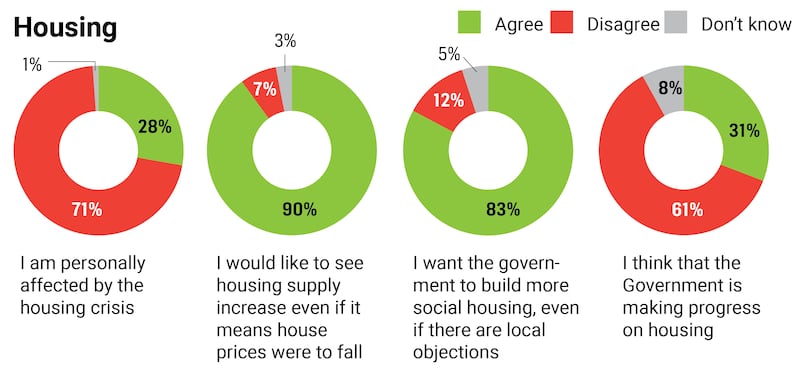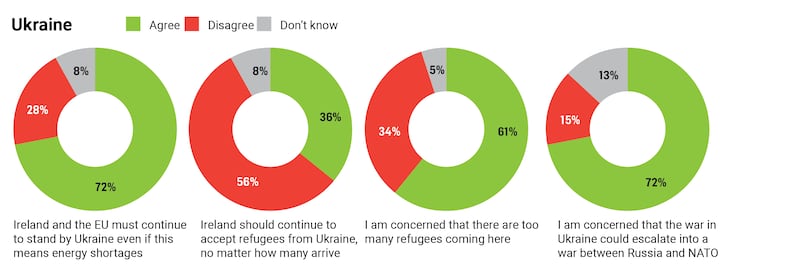The September budget appears to have hit the right note. Two in every three voters (65 per cent) agree that actions taken within the budget will help cushion the impact of inflation.
Not surprisingly Fianna Fáil (82 per cent), Fine Gael (79 per cent) and Green Party (68 per cent) voters overwhelmingly endorse the cost–of–living initiatives contained within Budget 2023. Even a majority of Sinn Féin voters (55 per cent) acknowledge that the budget will go some way towards alleviating the pain of rising prices.
Conducted on Sunday, Monday and Tuesday of this week among a representative sample of 1,200 eligible voters, the latest Irish Times/Ipsos poll focused on public attitudes towards how the Government is responding to the cost–of–living challenge.
For many households inflation is at crisis levels, with 44 per cent of respondents finding it a lot more difficult to manage financially nowadays. Those aged 25-49 years, with perhaps significant financial commitments including rent, childcare, school/college fees and mortgages, are the most likely to struggle (48 per cent).
RM Block

No one group in society is immune to the corrosive effects of inflation; only among the better off in our society (the AB social class – on 31 per cent) and among those from farming backgrounds (32 per cent) does the proportion finding it a lot more difficult to manage fall below one in three.
Opinion on whether the Government can be blamed for inflation is divided, with 49 per cent holding it responsible (down from 54 per cent in July) and 45 per cent agreeing it is largely out of the Government’s control (up from 38 per cent in July).
Concern that Government action could actually make things worse has declined, down from 64 per cent in July to 59 per cent in this latest poll. A focus on one-off payments in the budget may have helped alleviate some fears that the Government would set off a wage/welfare price spiral, with agreement among the public that wage increases could make things worse dropping from 52 per cent to 48 per cent.
Also investigated in this week’s poll are the issues of housing and the war in Ukraine.
On housing, a positive for the Government is a modest increase (to 31 per cent from 27 per cent in July) in the number of voters who agree progress is being made. Not so positive is the fact that still only 31 per cent agree progress is being made.

Attitudes towards the Government’s performance on housing depends to a great extent on which party you support. For Sinn Féin voters, it is a definite thumbs down, with just 20 per cent agreeing the Government is doing enough. Among Green voters (34 per cent agree) and Fine Gael voters (41 per cent agree), the jury is still out. Only among Fianna Fáil voters (55 per cent agree) is there majority agreement that progress is being made.
When it comes to public support for measures to tackle the housing crisis the electorate claims to be willing to see house prices drop (90 per cent) or accept more social housing in their local area (83 per cent). Whether or not politicians can bank these good intentions is debatable.
The Irish public’s response to the war in Ukraine has gone beyond good intentions, with Ireland playing its part in providing aid and accepting refugees. This week’s poll reveals a firmness of conviction to stay the course, with a large majority (72 per cent) agreeing Ireland and the EU should continue to stand by Ukraine even if this means energy shortages.

How many more refugees can Ireland accept remains an open question. Already 61 per cent of voters are concerned that there are too many refugees coming here. Only a minority of voters (36 per cent) agree we should accept refugees from Ukraine no matter how many arrive.
Not all demographic groups hold the view that we should limit the numbers of refugees. The youngest (those aged18-24 – 55 per cent) and the most affluent (ABs – 53 per cent) are in favour of accepting as many refugees as arrive.
Of greater concern to the Irish electorate than the number of refugees arriving from Ukraine, and a concern shared by 72 per cent of voters, is the risk that the conflict could escalate into a war between Russia and Nato. Fear of escalation is evenly distributed across the voter population, crossing all age and affluence groups.












